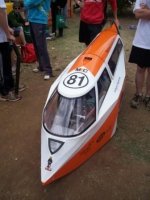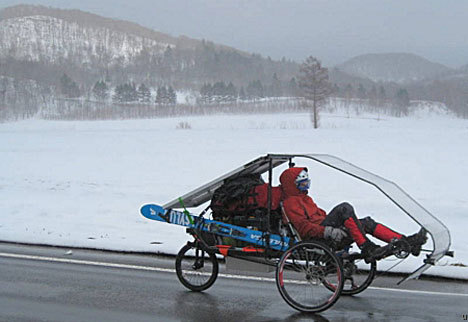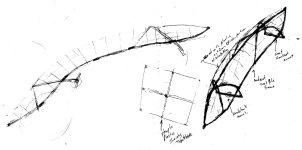I dream of a velomobile / enclosed trike. There's the elements in these areas and biking or triking through snow isn't too fun! But, I don't know where to start.
I've been looking at commercial velomobiles but considering how small the market is, they always seem to be above 3000 dollars and they're typically above 5000! Yikes! Do fairings really cost that much?
(There's also no model that does what I want) ... So it looks like I'll have to make it myself. But, how would I do so?
Ideally, it should be light but still sturdy enough for higher speed demands so it should be built "sturdy" like a motorcycle. I think I'd be fine with non-highway use so I'd imagine 45 mph might be good enough but, you know, if it can easily go highway speeds, why should I limit myself? I also want it to be as aerodynamic as practical so as to maximize how much range I can get from an affordable amount of batteries. I also want enough room for a passenger, but to keep it optimized in being aerodynamic, it'd be a back seat right behind the front seat (The back seat would also serve as the cargo area). It'd also be nice if both people could pedal. Also, enough clearance for snow would be nice (a foot or two), but I also want to keep the platform stable so the seats should be low to ground and the two rear wheel should be relatively wide. I don't imagine this would be something I would take on bike paths or sidewalks and, hey, that's why I have my electric scooter or foldable electric bike in the back seat for. I also want "to be seen", and so nice high bars with bright lighting to announce there's a person there would be nice, but it should also be fairly aerodynamic so the frontal area should be small. Also, full suspension would be nice. I think that'd be one spring for the front and two springs for the back? It should also be as light as practical without costing a whole lot (So carbon fiber probably isn't a possibility, but maybe some cheap metal with some sort of fabric would work?) so that I could make it up hills with reasonable speeds. It would also be cool if both people could pedal. In 30 mph traffic, it seems like it would be awesome to travel at that speed with pedal power alone without undue fatigue due to the excellent aerodynamics of a fully faired "recumbent" trike. I calculated the probable effective drag coefficient to be something like 4 times less than a normal biker with lower being possible, and so it'd only take about 200 watts to maintain 30 mph on flat ground and I think I calculated something like 11 wh/mi going 30 mph on motor power alone. That implies it'd take a pretty minimal amount of capacity to get a decent range and so batteries wouldn't cost so flipping much. Heck, at 11 wh/mi, a 48v10ah pack could go something like 40-50 miles on motor power alone! If you pedal at all, you could have outstanding range.
I also want it to be as aerodynamic as practical so as to maximize how much range I can get from an affordable amount of batteries. I also want enough room for a passenger, but to keep it optimized in being aerodynamic, it'd be a back seat right behind the front seat (The back seat would also serve as the cargo area). It'd also be nice if both people could pedal. Also, enough clearance for snow would be nice (a foot or two), but I also want to keep the platform stable so the seats should be low to ground and the two rear wheel should be relatively wide. I don't imagine this would be something I would take on bike paths or sidewalks and, hey, that's why I have my electric scooter or foldable electric bike in the back seat for. I also want "to be seen", and so nice high bars with bright lighting to announce there's a person there would be nice, but it should also be fairly aerodynamic so the frontal area should be small. Also, full suspension would be nice. I think that'd be one spring for the front and two springs for the back? It should also be as light as practical without costing a whole lot (So carbon fiber probably isn't a possibility, but maybe some cheap metal with some sort of fabric would work?) so that I could make it up hills with reasonable speeds. It would also be cool if both people could pedal. In 30 mph traffic, it seems like it would be awesome to travel at that speed with pedal power alone without undue fatigue due to the excellent aerodynamics of a fully faired "recumbent" trike. I calculated the probable effective drag coefficient to be something like 4 times less than a normal biker with lower being possible, and so it'd only take about 200 watts to maintain 30 mph on flat ground and I think I calculated something like 11 wh/mi going 30 mph on motor power alone. That implies it'd take a pretty minimal amount of capacity to get a decent range and so batteries wouldn't cost so flipping much. Heck, at 11 wh/mi, a 48v10ah pack could go something like 40-50 miles on motor power alone! If you pedal at all, you could have outstanding range.
So, any guesstimates on what kind of equipment I would need to finish a project like this? Any ideas as to how much it would probably cost in materials to build the base platform? Any tricks, suggestions, pitfalls, etc. that I should know about? Does anyone else have a dream like this? Could I get this registered as a motorcycle so I could legally maintain higher speeds?
Also, I don't really care about the cabin temperature, I'm just more interested in keeping the cold wind, snow and precipitation out of my face, so a skeleton with some kind of fabric would probably suit me fine for the body. For the viewing areas where there's be windows and a windshield, perhaps some kind of clear plastic? Maybe I'd use something sturdier for the windshield to protect against projectiles, but I do want to keep the weight down. Keeping it down to 100 pounds would be a dream and an initial goal. I absolutely want to keep it under 200 pounds to minimize the motor/controller/battery requirements and costs to maintain reasonable speeds up hills.
I've been looking at commercial velomobiles but considering how small the market is, they always seem to be above 3000 dollars and they're typically above 5000! Yikes! Do fairings really cost that much?
(There's also no model that does what I want) ... So it looks like I'll have to make it myself. But, how would I do so?
Ideally, it should be light but still sturdy enough for higher speed demands so it should be built "sturdy" like a motorcycle. I think I'd be fine with non-highway use so I'd imagine 45 mph might be good enough but, you know, if it can easily go highway speeds, why should I limit myself?
So, any guesstimates on what kind of equipment I would need to finish a project like this? Any ideas as to how much it would probably cost in materials to build the base platform? Any tricks, suggestions, pitfalls, etc. that I should know about? Does anyone else have a dream like this? Could I get this registered as a motorcycle so I could legally maintain higher speeds?
Also, I don't really care about the cabin temperature, I'm just more interested in keeping the cold wind, snow and precipitation out of my face, so a skeleton with some kind of fabric would probably suit me fine for the body. For the viewing areas where there's be windows and a windshield, perhaps some kind of clear plastic? Maybe I'd use something sturdier for the windshield to protect against projectiles, but I do want to keep the weight down. Keeping it down to 100 pounds would be a dream and an initial goal. I absolutely want to keep it under 200 pounds to minimize the motor/controller/battery requirements and costs to maintain reasonable speeds up hills.







